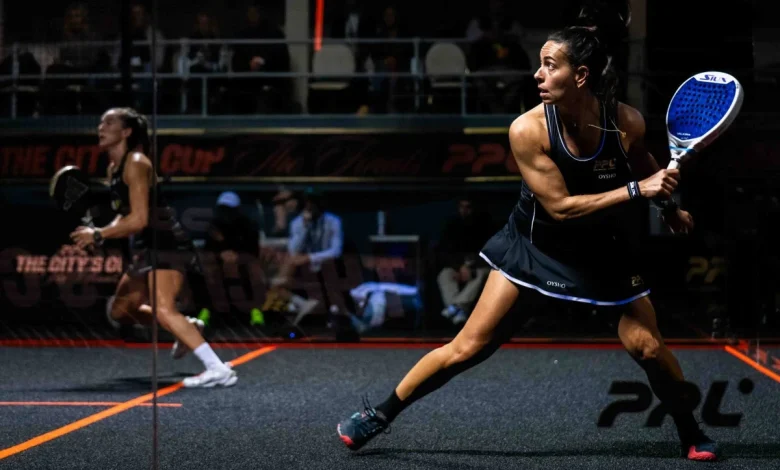Padel is growing in the U.S as investment booms. Is its mission to rival tennis realistic? – The Athletic

“I live in a community in Delray Beach, Florida. We had 14 tennis courts, two padel courts and eight pickleball courts. We are now going to have four padel courts, and the way that we can build those additional courts is by converting tennis courts. The sport that is going to suffer at the expense of padel is tennis.”
David Eisen, one of the newest investors in the North American Pro Padel League (PPL), believes he is at the start of a revolution that will upend the existing order of racket sports. Given he has just acquired the Los Angeles Beat padel franchise, at a valuation of $10 million (£7.6m), it is probably in his interests to say that — and for his community’s ratio of tennis courts to padel courts to swing further in his favor.
Padel, played on an enclosed court using skills and rules that make it a kind of hybrid of tennis and squash, is experiencing a wave of investment in the United States, with PPL franchises being acquired at rising valuations. The league currently comprises 10 teams in nine cities and one state: Toronto, San Diego, New York, Miami, Las Vegas, Cancun, Los Angeles, Houston, Orlando and Arkansas.
U.S. tennis player Frances Tiafoe, who is ranked inside his sport’s top 30, recently became an adviser to the New York Atlantics PPL franchise, as part of a funding round that the league said exceeded $2 million. The deal valued the Atlantics at over $10 million, up from the $200,000 entry fee that franchises paid to join the league in 2023.
Perhaps this explains Eisen’s buoyancy. “I see the league potentially growing by leaps and bounds in valuations,” he told The Athletic.
Richard Nicolson, the president of the Miami team, pointed to other burgeoning leagues for inspiration. “The numbers are astronomical. If you look at MLS, the WNBA, emerging professional volleyball leagues, or professional bull riding…”
For the uninitiated, Professional Bull Riders stages more than 200 live events per year. ESPN reported that it reaches over 285 million households, in more than 60 territories.
“They had 50 applications for their last franchise and the starting bid was $20 million,” Nicolson said.
Padel has grown in recent years, with an estimated 30 million players globally, after originating in Mexico. In Spain, some studies claim it is the second-most popular participation sport. Spain has the most padel courts in the world (more than 17,000), according to the International Padel Federation, followed by Italy and Argentina.
In the United Kingdom and U.S., it has become the pastime of choice for celebrities and aristocrats. The Prince of Wales, William, and his Princess Catherine have been spotted playing. David Beckham and Eva Longoria are among those who have caught the bug, while three-time Grand Slam champion Andy Murray, who learned the game while training in Spain, has invested in U.K. operator Game4Padel.
In the U.S., however, it remains a nascent sport, professionally and recreationally. There is no American among the top 200 men’s players, with world No. 211 Vinny Nahuel Di Francesco one of only two in the top 400. Brittany Dubins is the top-ranked American woman, at No. 93, but also one of only two in the top 400. Sixteen of the top 20 women are Spanish, along with three Argentines and a Portuguese player. In the men’s game, there are 13 Spaniards in the top 20, along with six Argentines and a Brazilian.
The North American PPL is importing talent to draw interest. Agustín Tapia, the Argentine world No.1 men’s player, has represented the Miami team during the past season, and the women’s No. 3 Ariana Sánchez competed for the New York Atlantics. The PPL has also taken events outside of North America. The 2025 season took place in Miami, San Sebastián (Spain), Guadalajara (Mexico), The Hamptons (New York) and ended in New York City, at the Hammerstein Ballroom.
The Pro Padel League has attracted some of its top international stars, including Agustín Tapia and Jairo Bautista. (Arturo Holmes / Getty Images)
At the New York City event, tickets ranged from $20 to $190 VIP experiences. Adidas sponsored the court. The total prize pool, combining salaries and performance, was $4 million for the season.
“The players are really appreciative that they’re not going to walk away with zero,” Michael Dorfman, the chief executive of PPL, said.
“And there’s an incentive in that they’re motivated to get on the court and perform. The New York City event was $250,000 for the total purse.”
Hosting these events does not come cheap. A spokesperson for the league said the PPL would not share ticketing or financial details for this past season. Dorfman concedes that some events are seen as loss leaders, or, as he puts it, investments.
“But when we go to Mexico or Spain, it’s a very different story,” he said. “Ultimately, we want to build this for a U.S. audience. It’s the largest sports market in the world, for every other sport in the world. We know that’s going to take time.
“It’s about finding the right blend of events and the right markets, where we can be profitable in some areas and recycle those profits into investments in other markets we believe in the long term will be big. Formula 1 has done a great job. Once they got it to stick in Miami, Las Vegas and Austin, it became a very different property.”
Some are skeptical of padel’s appeal to a television audience in the U.S., viewing it as more of a hobby than a mass-market media rights proposition. Dorfman believes padel is already proving itself.
“We’re not guessing whether the sport is going to be popular or not,” he said.
“We’ve seen it rise to an insane level of popularity in over 100 countries and it’s going to be no different here. We have several paid media rights deals already. The vast majority of our viewers today are international. In Mexico, we have a deal for TV that is paid. We have a bifurcated approach where we can monetize the international mature audience for padel while investing in the U.S.”
PPL is broadcast on YouTube, Tennis Channel and Telemundo, but these are not paid deals. The league is trying to maximize its market by proving the audience first. This is a common approach for emerging leagues.
Eisen, the owner of the L.A. team, said media is “the most important and most difficult” revenue lever to pull, while Nicolson of the Miami team said: “U.S. based streaming numbers have gone up dramatically in the last six to 10 months, which is extremely exciting.
“This is a dual exercise — in showcasing the top players in the world but also introducing a sport to the biggest market in the world.”
PPL has held discussions with streaming platforms for docuseries about players and teams, but one challenge for storytellers targeting a U.S. audience is that few of the PPL’s star players are fluent in English. Eisen also wants to involve stars from different sports in his L.A. ownership, as has become a familiar trend in European soccer. Dorfman points out that padel is hugely popular among F1 drivers, soccer stars and a “whole lot of NHL players,” while Argentina’s Tapia has linked up with Lionel Messi at Inter Miami’s training complex. Plans are afoot for next summer’s World Cup, which will be hosted in the United States, Canada and Mexico.
One obstacle for padel in the U.S. is a lack of facilities. Padel courts are smaller than tennis courts, but planning permission is not always straightforward, partly because of the noise caused by the ball striking their walls.
Dorfman said there are only 700 courts across the country. “The U.K. has more courts than the U.S.,” he said.
“We’re nowhere near where we need to be. From a participatory standpoint, this year will end with around 500,000 participants in the U.S. That was under 100,000 last year. The demand to play padel is really high, but the clubs and the courts are just relatively inaccessible because they’re expensive to build.
“There were folks expecting to open clubs in six to 12 months, but it is actually taking 24 to 36 months. There are many projects in the pipeline in just about every city in the U.S. but it’s going to take us another year and a half for the majority of those to open.”
The PPL is seeking to raise more money and wants to be “a cash-flowing business sooner than later,” he said.
“We’re not in this to have a nice lifestyle business. We want to be a major competitive property on the landscape of spectator sports.”
Tennis, meanwhile, has 25.7 million participants, according to the United States Tennis Association — a number that has grown for five years in a row, while there are 270,000 courts across the U.S., according to the Racquet Industry Research Group.
Then there is pickleball, which had close to 20 million U.S. participants in 2024, according to the Sports and Fitness Industry Association. Padel, therefore, has plenty of catching up to do, or, in disruptor parlance, room for growth. While tennis does not appear to be on life support, plenty of its retired stars have taken a shine to padel, which is softer on most joints.
Rafael Nadal has an academy in Mallorca, Spain, while Juan Martin del Potro, the Argentine former world No. 3 tennis player, is a strategic adviser for the Miami padel team.
For Eisen and Nicolson, persuading players to swap tennis for padel is a priority. “It’s local tennis players at your local tennis club. When they try padel, they say, ‘I think I’m done with tennis, this is my new favorite sport,’” Nicolson said.
The numbers do not yet back up these claims. Eisen believes leading padel players will one day earn the same money as the biggest tennis stars, but “it is tough to say when.” The $4 million prize pool for one PPL season would not touch the sides of one Grand Slam champion’s winnings.
In the meantime, the priority is to create more courts for people to experience the sport. Eisen is so convinced that he has built a court at his home in the Hamptons. But padel will need far more accessible spaces if it is to go mainstream in the States, and Eisen too wants a younger generation of players and spectators.
“If you look at the court, it is different. It’s not like a tennis court. It’s engaging. It’s something that catches your eye. It looks great on Instagram,” he said.
“We need a mass audience,” Dorfman added. “The way the sport has grown and matured in most other countries has been the same funnel. It started in very wealthy demographics and trickled down to become more accessible.
“I don’t really have any interest in building the sport for just an elite class. We want thousands of people in the seats. We want kids playing. We want the sport to be affordable. It will get there. But the way most racket sports have made their way to the masses is by getting a very powerful group of people invested first.”





